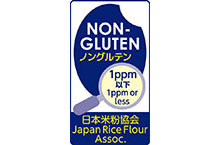Japanese agriculture, forestry, fisheries and food
Highlighted Japanese IngredientRice flour
What is rice flour?
Rice flour is made by milling rice. Like wheat flour, it can be used in making bread, confectionery and batter for frying, but in addition to being delicious it is also non-gluten and low in calories.

World's first non-gluten rice flour label (self-standard) starts.
Rice contains no gluten.
The world's first industrial self-regulatory "non-gluten rice flour label" has started in Japan. Based on its standards, the amount of gluten contained in a rice product that can be indicated as "non-gluten" is "1μg/g (=1ppm) or less."

Types of rice flour according to application and its main application
With the aim of expanding usage of rice flour, guidelines for labeling "non-gluten" rice flour products as well as criteria related to processing suitability for each of the categories of "confectionary and cooking," "bread" and "noodles" have been published.

A wide variety of dishes can be cooked with rice flour products based on their designated applications.




Makes cooking delicious food easy
As rice flour contains no gluten, it does not form lumps or congeal during the cooking process, making sifting unnecessary. On top of that, it can be used to add a variety of textures to food, from springiness to crispiness, or even as a thickening agent. It is an extraordinary ingredient which makes cooking delicious and easy no matter what it is used for.
Puffy and tasty
Bread and noodles made from rice flour have a pleasant soft and springy texture.
Light and healthy due to low oil uptake
The oil uptake of rice flour is lower than that of wheat flour. For example, tempura coated with rice flour maintains a light crispy texture longer than that with wheat flour.
- Percentage of oil uptake of batters for fried chicken thighs:
-
Rice flour: 21%
Wheat flour: 38% -
Source:
Conditions Regarding Rice Flour in Japan, the Ministry of Agriculture, Forestry and Fisheries of Japan
Oil Uptake Properties of Fried Batters from Rice Flour, F. Shin and K. Daigle (J. Agric. Food Chem. 47 [1999])
Excellent amino acid balance enables you to keep your skin and hair healthy.
Rice flour has an advantage in its balance of amino acids, which are essential to our diet.
Rice flour has an excellent balance of amino acids necessary for people. These amino acids constitute proteins that make up important tissues of the body, such as muscles and internal organs.
- Amino acid scores:
-
Rice flour: 65
Wheat flour: 41 - * The scores are calculated based on polished white rice and medium‐strength wheat flour, using the 1973 FAO/WHO evaluation pattern.2 The amino acid score is the lowest value among the percentages of nine individual essential amino acids calculated by dividing the amount contained within the protein of the product by the standard value essential for people (with scores here based on FAO/WHO evaluation patterns for 1973 and 1985). If all nine amino acid values meet each standard value, the score becomes 100.
-
Source:
- Conditions Regarding Rice Flour in Japan, the Ministry of Agriculture, Forestry and Fisheries of Japan
- Protein and Amino Acid in Food Products, the National Institute of Resources of the Science and Technology Agency (1986)
List of related links
- List of exporters of Japanese rice flour
- JAFEX (Japan Agricultural & Foodstuff Exports)



